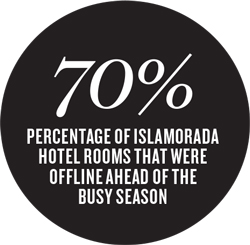When Hurricane Irma barreled through South Florida in September, it lashed the region with a torrent of wind and water not seen since Hurricane Andrew a quarter century earlier. And while South Florida’s mainland bounced back with relative ease, the Florida Keys — where Irma hit head-on as a Category 4 storm — suffered far worse.
Of all the commercial real estate sectors impacted by the storm in the region, none was harder hit than hospitality in the Keys. About 28 percent of the area’s 11,000 hotel rooms remained closed as the holiday season got under way, and many lodgings expected to remain shuttered until well into the winter and beyond, according to Andy Newman, who heads publicity efforts for the Keys’ Monroe County Tourist Development Council.
“I don’t have a crystal ball to sit there and really project numbers,” Newman said. “But obviously we are going to have deficits this year compared to last year in terms of the tourist development tax dollars. That’s very, very apparent.”
As a result of that huge reduction in inventory, Irma’s devastation had the counterintuitive effect of leading to healthier hotel market numbers for the area, with RevPAR (revenue per available room) in the Keys jumping 13.1 percent year-over-year in October, to $165.
Who was hit hardest
The impact on the Keys hotel sector has diverged substantially across the islands. Islamorada was hit the hardest, even though the town is located farther from the spot where the storm made landfall than any portion of the Keys other than Key Largo. About 70 percent of the Islamorada area’s 1,275 rooms were offline ahead of Thanksgiving, with most of the closures expected to last until at least mid-January and some expected to continue into the summer. The disproportionately high percentage of Islamorada hotels that sit along the Keys’ Atlantic shore, where Irma’s storm surge was highest, explain why it was hardest hit.
 The ripple effects were felt throughout the economy of the 6,600-person town this fall, Islamorada Chamber of Commerce Executive Director Judy Hull said.
The ripple effects were felt throughout the economy of the 6,600-person town this fall, Islamorada Chamber of Commerce Executive Director Judy Hull said.
“Where visitors stay is where they spend their money, so the trickle down effect is what we’re feeling,” she said.
September to November is Islamorada’s lightest three-month stretch for tourism, even in a normal year. But the impact of the closures could be worse as Islamorada moves into the heart of its tourist season, January to April, when local hotels collected 42 percent of their bed taxes in 2016, according to county records.
Among the many Islamorada hotels damaged by Irma were the four run by the Carlyle Group-owned Islamorada Hotel Company: the 132-room Amara Cay, the 150-room Postcard Inn, the 63-room Pelican Cove and the 54-room La Siesta. Amara Cay was scheduled to reopen on December 15, followed by Pelican Cove on January 12. Postcard Inn and La Siesta will open later in 2018, the Islamorada Hotel Company said.
Other prominent Islamorada hotel closures include the 114-room oceanside portion of Islander Resort, where the reopening will likely occur between June and September 2018, according to general manager Scott Simmons.
Simmons said that all of the resort’s rooms suffered water damage during Irma. When the units reopen, they’ll be upgraded with hurricane glass windows as well as central air-conditioning, he said.
Key West, by far the largest driver of Keys tourism, was spared major damage as it was hit only by the weak left-hand side of Irma. As a result, the town recovered rapidly. Ninety-five percent of the hotel rooms in the southernmost Keys’ city and neighboring Stock Island were open by mid-November, and some 90 percent were already open during the last week of October, when Key West held Fantasy Fest, its largest annual event.
About 75 miles from where Irma made landfall, the Key Largo area had 76 percent of its hotel rooms online as of mid-November; most of the closed rooms belong to Hilton Key Largo and Ocean Pointe. Ocean Pointe expects to open its 170 suites in mid-winter, Newman said. The 200-room Hilton, which was already under renovation when Irma occurred, sustained roof damage from the storm and is expected to be offline until next summer.
In the Marathon area of the Middle Keys, much closer to where Irma hit, only 50 percent of rooms were open as of mid-November. The most prominent closure is Hawks Cay Resort, which decided to renovate its lobby and all 177 hotel guest rooms after Irma’s winds and storm surge caused extensive damage. Reopening is planned for late summer 2018.
In the Lower Keys and Big Pine Key area, which is the least touristy part of the island chain and typically brings in just 5 to 6 percent of Keys bed taxes, just 46 percent of rooms were open ahead of the high season. Among the shuttered properties is the posh Little Palm Island Resort & Spa, which sits offshore of Little Torch Key, where it was ravaged head-on by Irma. The 30-room resort is expected to be closed for up to a year.
A prettier picture up north
Irma’s impact on Miami’s hotel room availability was relatively minimal. As of early November, approximately 2,100 of the Miami area’s 55,000 hotel rooms were offline, said Rolando Aedo, chief marketing officer of the Greater Miami Convention & Visitors Bureau. And only about half of those closures were related to Irma.
In fact, Aedo said, the area might actually benefit in the aftermath of the rough hurricane season, which also ravaged popular winter tourist destinations in the Caribbean.
“We’ve been receiving calls from businesses and meeting planners that have had to move some of their business from the Caribbean,” he said. “We would never want to benefit from other people’s loss per se, but it is something that we’ve seen.”
